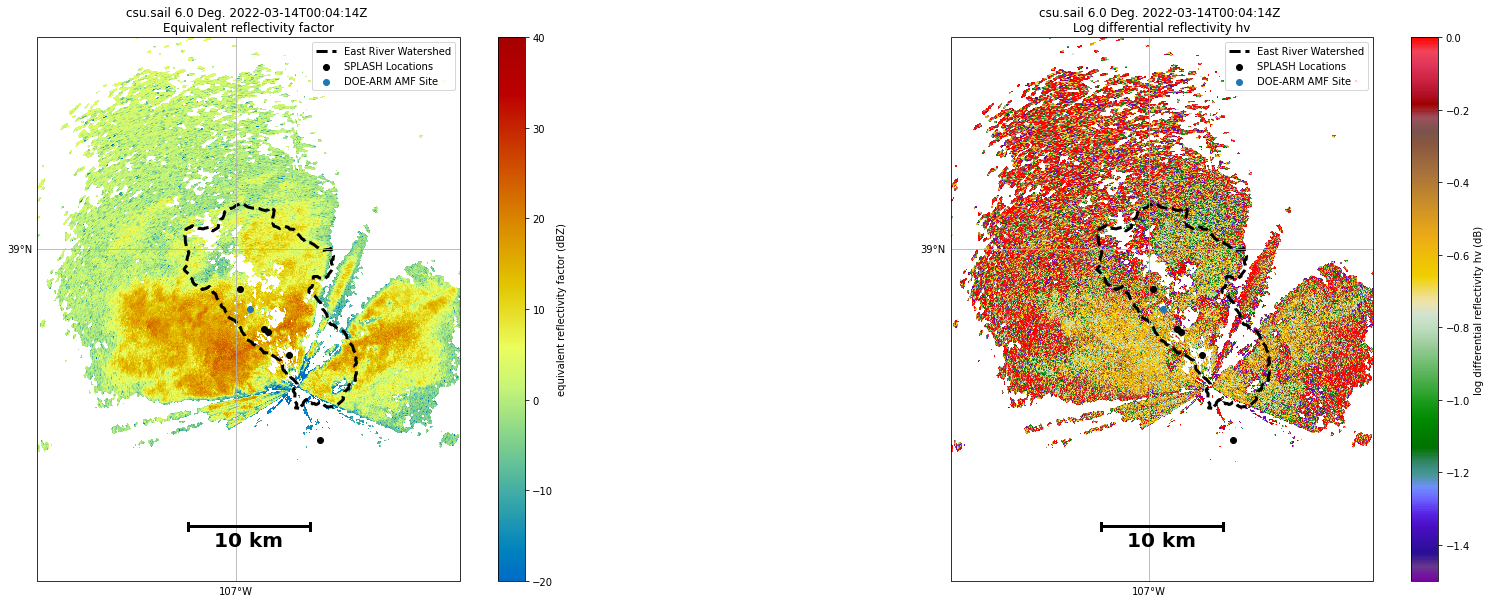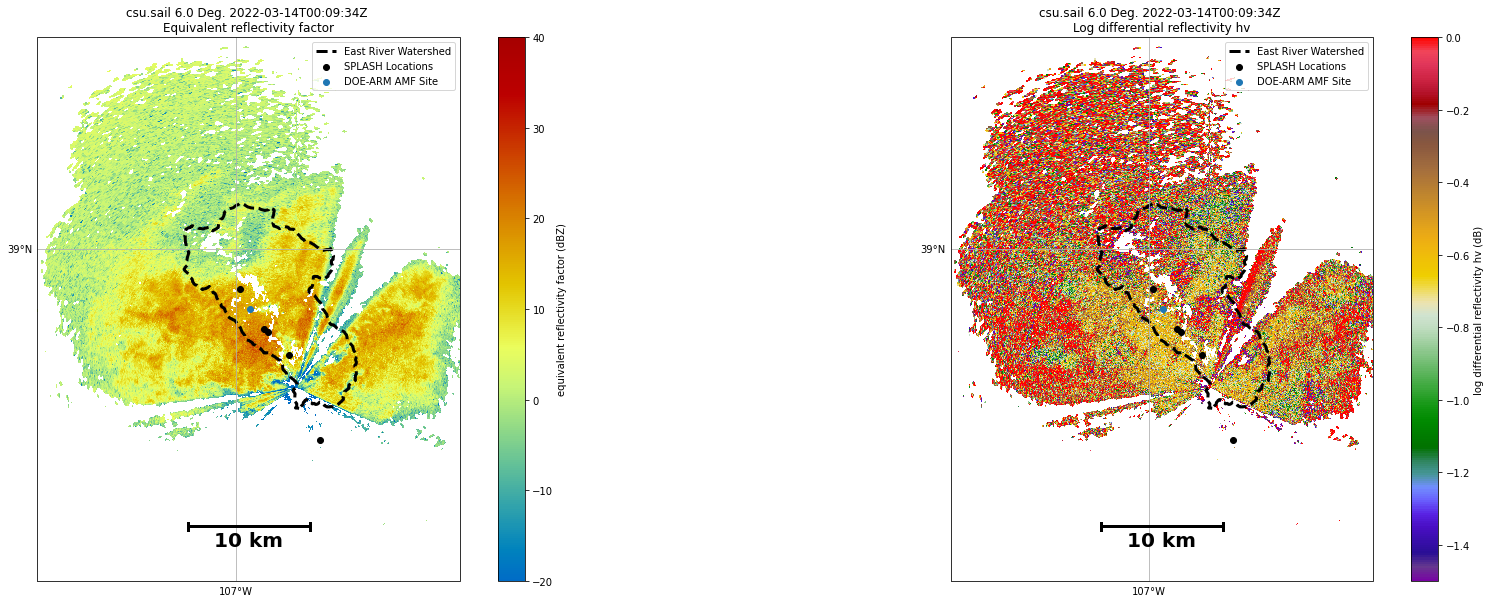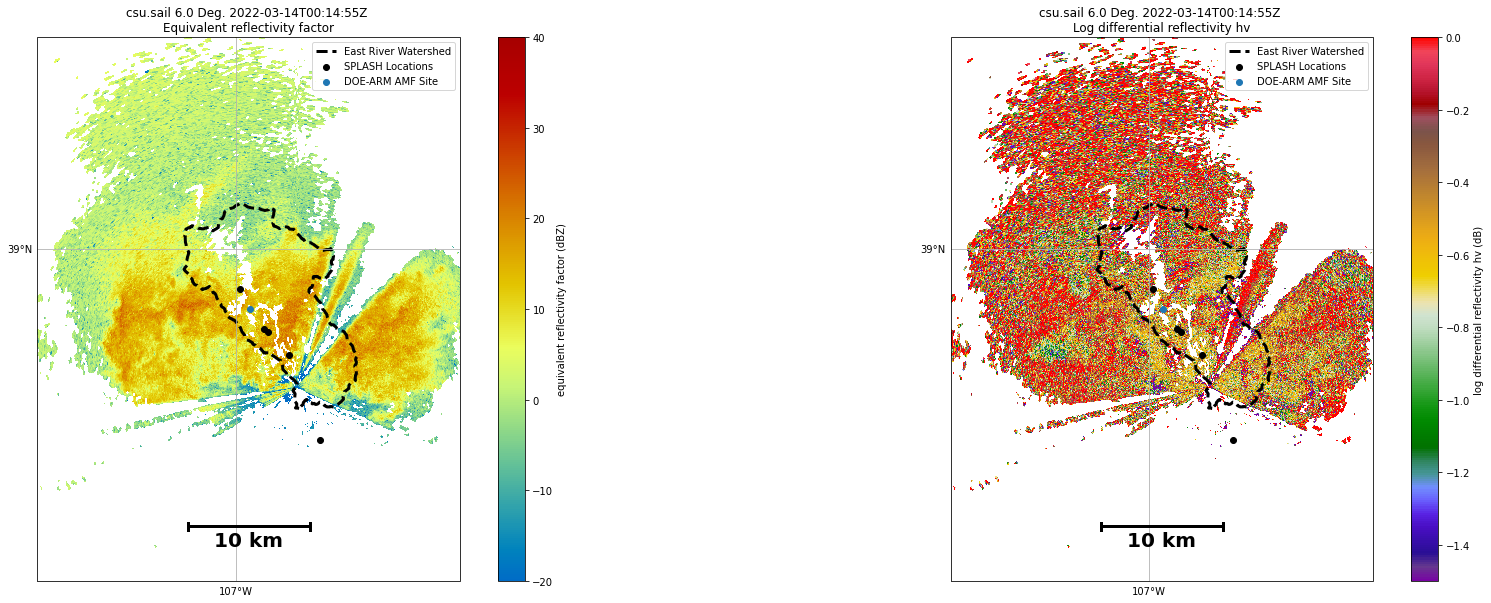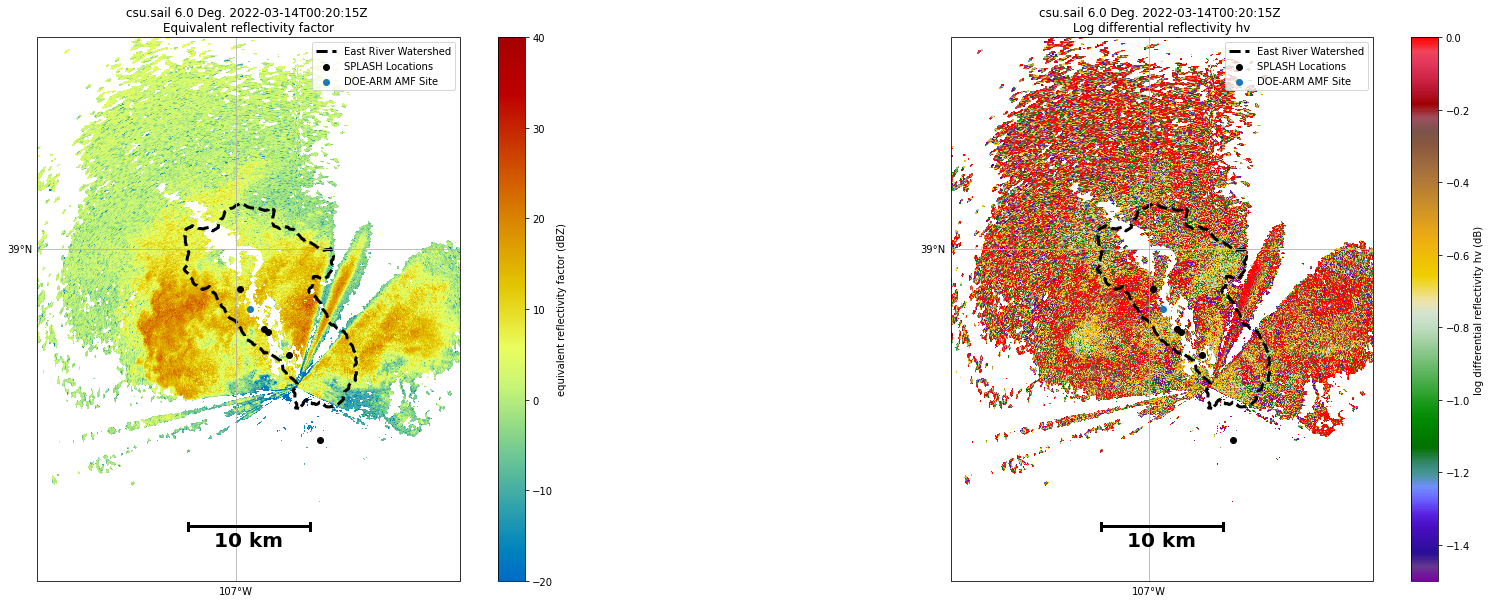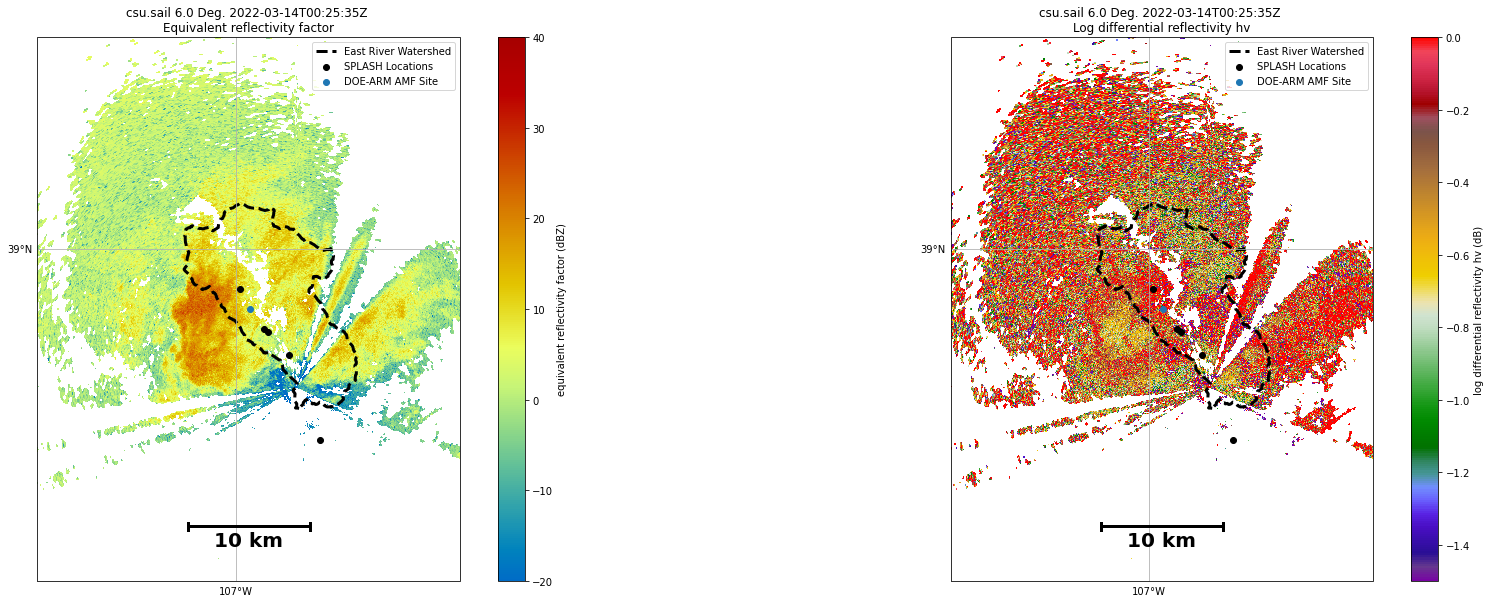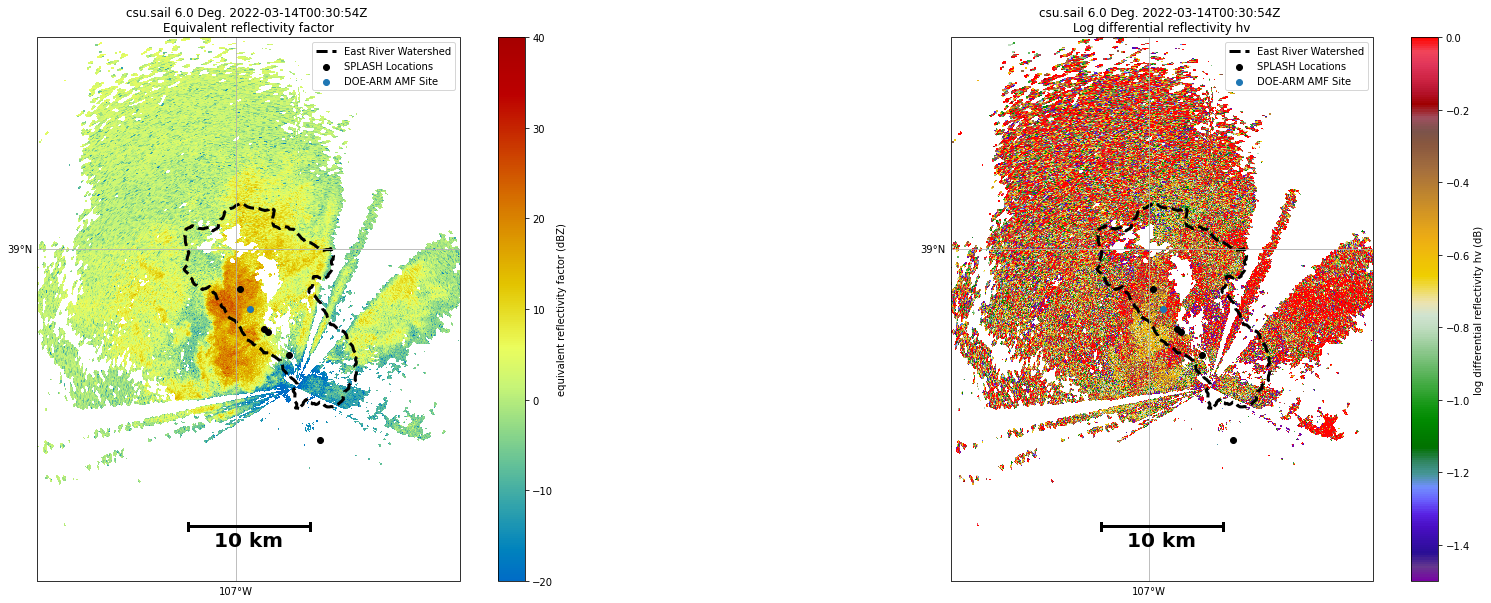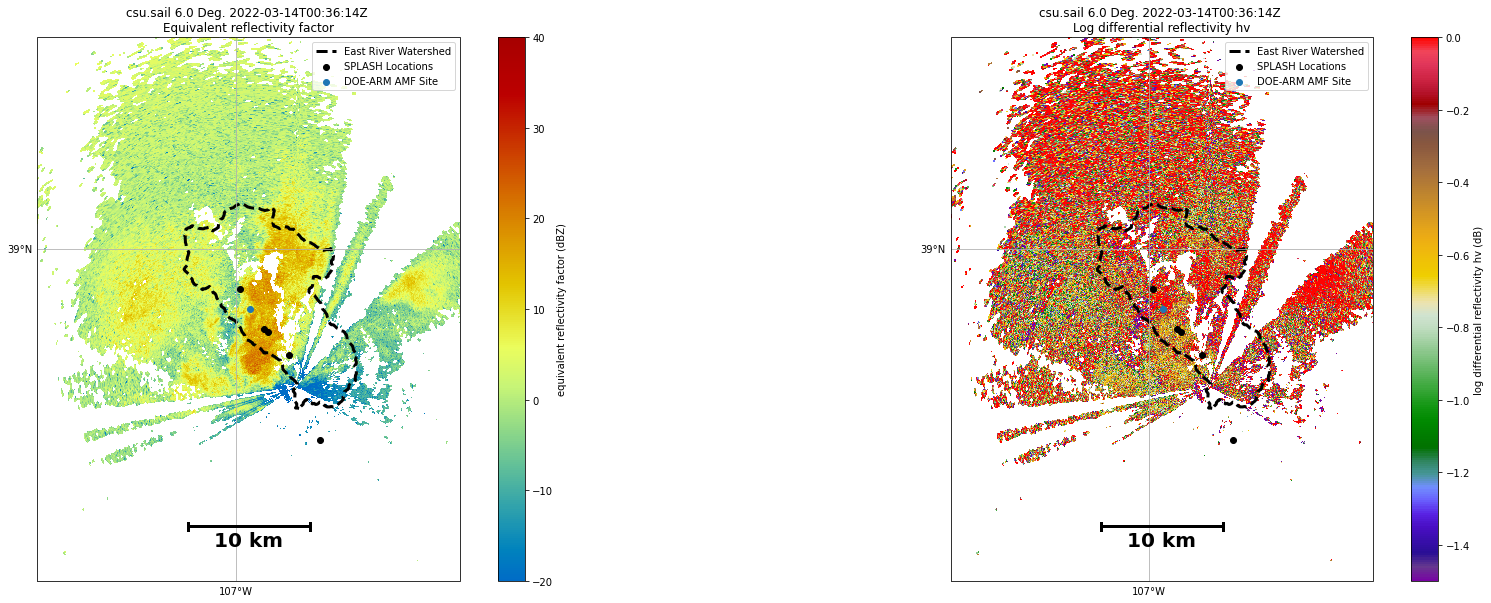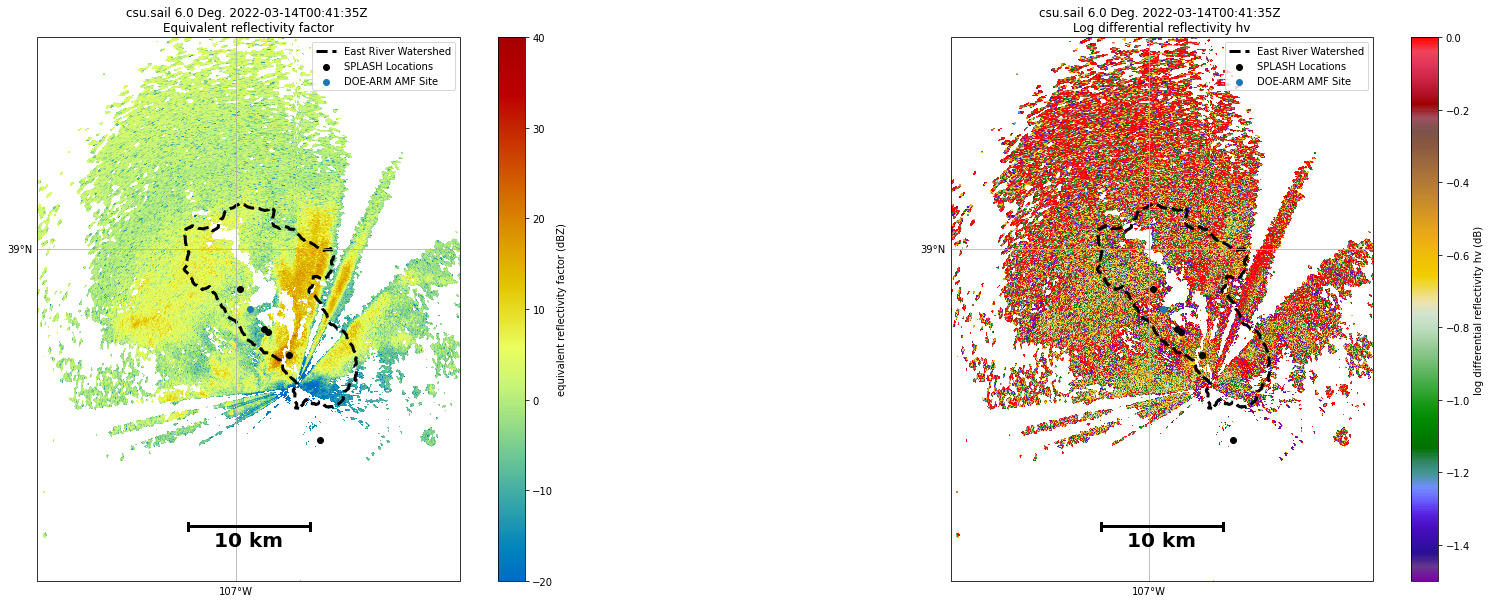X-Band PPI Analysis
Contents
X-Band PPI Analysis¶
During this same analysis period, there was an X-Band radar operated by CSU scanning in both PPI/RHI scan modes
Imports¶
import pyart
import glob
import xarray as xr
import matplotlib.pyplot as plt
import cartopy.crs as ccrs
import numpy as np
from math import atan2 as atan2
import warnings
import hvplot.xarray
import holoviews as hv
import geopandas as gpd
import fiona
fiona.drvsupport.supported_drivers['libkml'] = 'rw' # enable KML support which is disabled by default
fiona.drvsupport.supported_drivers['LIBKML'] = 'rw' # enable KML support which is disabled by default
warnings.filterwarnings("ignore")
hv.extension('bokeh')
Data Overview¶
The data were accessed from the ARM data portal - here is a link to the specific query, with our date being March 14, 2022
We will be looking at the 6 degree elevation scan, since there is better data coverage in the clouds/less beam blockage due to terrain
Analysis Workflow¶
Read in the Data¶
We grab the files from the following directory, after ordering from the data portal and unzipping the archive
radar_files = sorted(glob.glob('../../data/x-band/ppi/*6_PPI.nc'))
Setup Helper Functions¶
We include some helper functions to build the scale bar for the plots
def gc_latlon_bear_dist(lat1, lon1, bear, dist):
"""
Input lat1/lon1 as decimal degrees, as well as bearing and distance from
the coordinate. Returns lat2/lon2 of final destination. Cannot be
vectorized due to atan2.
"""
re = 6371.1 # km
lat1r = np.deg2rad(lat1)
lon1r = np.deg2rad(lon1)
bearr = np.deg2rad(bear)
lat2r = np.arcsin((np.sin(lat1r) * np.cos(dist/re)) +
(np.cos(lat1r) * np.sin(dist/re) * np.cos(bearr)))
lon2r = lon1r + atan2(np.sin(bearr) * np.sin(dist/re) *
np.cos(lat1r), np.cos(dist/re) - np.sin(lat1r) *
np.sin(lat2r))
return np.rad2deg(lat2r), np.rad2deg(lon2r)
def add_scale_line(scale, ax, projection, color='k',
linewidth=None, fontsize=None, fontweight=None):
"""
Adds a line that shows the map scale in km. The line will automatically
scale based on zoom level of the map. Works with cartopy.
Parameters
----------
scale : scalar
Length of line to draw, in km.
ax : matplotlib.pyplot.Axes instance
Axes instance to draw line on. It is assumed that this was created
with a map projection.
projection : cartopy.crs projection
Cartopy projection being used in the plot.
Other Parameters
----------------
color : str
Color of line and text to draw. Default is black.
"""
frac_lat = 0.1 # distance fraction from bottom of plot
frac_lon = 0.5 # distance fraction from left of plot
e1 = ax.get_extent()
center_lon = e1[0] + frac_lon * (e1[1] - e1[0])
center_lat = e1[2] + frac_lat * (e1[3] - e1[2])
# Main line
lat1, lon1 = gc_latlon_bear_dist(
center_lat, center_lon, -90, scale / 2.0) # left point
lat2, lon2 = gc_latlon_bear_dist(
center_lat, center_lon, 90, scale / 2.0) # right point
if lon1 <= e1[0] or lon2 >= e1[1]:
warnings.warn('Scale line longer than extent of plot! ' +
'Try shortening for best effect.')
ax.plot([lon1, lon2], [lat1, lat2], linestyle='-',
color=color, transform=projection,
linewidth=linewidth)
# Draw a vertical hash on the left edge
lat1a, lon1a = gc_latlon_bear_dist(
lat1, lon1, 180, frac_lon * scale / 20.0) # bottom left hash
lat1b, lon1b = gc_latlon_bear_dist(
lat1, lon1, 0, frac_lon * scale / 20.0) # top left hash
ax.plot([lon1a, lon1b], [lat1a, lat1b], linestyle='-',
color=color, transform=projection, linewidth=linewidth)
# Draw a vertical hash on the right edge
lat2a, lon2a = gc_latlon_bear_dist(
lat2, lon2, 180, frac_lon * scale / 20.0) # bottom right hash
lat2b, lon2b = gc_latlon_bear_dist(
lat2, lon2, 0, frac_lon * scale / 20.0) # top right hash
ax.plot([lon2a, lon2b], [lat2a, lat2b], linestyle='-',
color=color, transform=projection, linewidth=linewidth)
# Draw scale label
ax.text(center_lon, center_lat - frac_lat * (e1[3] - e1[2]) / 4.0,
str(int(scale)) + ' km', horizontalalignment='center',
verticalalignment='center', color=color, fontweight=fontweight,
fontsize=fontsize)
Configure our Main Plotting Function¶
We use the RadarMapDisplay from PyART as the main plotting utility, with a few customizations
def plot_ppi(file,
centerlon,
centerlat,
other_field='ZDR',
splash_locations=splash_locations,
arm_doe_locations=arm_doe_locations,
east_river=east_river):
# Read in the data using pyart
radar = pyart.io.read_cfradial(file)
# Quickly qc data using velocity texture
vel_texture = pyart.retrieve.calculate_velocity_texture(radar, vel_field='VEL', wind_size=3, nyq=33.4)
radar.add_field('velocity_texture', vel_texture, replace_existing=True)
# Add a gatefilter, and filter using a threshold value of 4 - could be refined
gatefilter = pyart.filters.GateFilter(radar)
gatefilter.exclude_above('velocity_texture', 4)
# Setup our figure
fig = plt.figure(figsize=(30, 10))
#delta lat lon degrees
window = 0.2
locbox = [centerlon - window, centerlon + window, centerlat - window, centerlat + window]
# create the plot
ax1 = fig.add_subplot(121, projection=ccrs.PlateCarree())
# Setup a RadarMapDisplay, which gives our axes in lat/lon
display = pyart.graph.RadarMapDisplay(radar)
# Add our reflectivity (DBZ) field to the plot, including our gatefilter
display.plot_ppi_map('DBZ', 0, ax=ax1, vmin=-20, vmax=40.,
gatefilter=gatefilter)
# Set our bounds
plt.xlim(locbox[0], locbox[1])
plt.ylim(locbox[2], locbox[3])
splash_locations.plot(ax=ax1,
color='black',
label='SPLASH Locations')
arm_doe_locations.plot(ax=ax1,
color='tab:blue',
label='DOE-ARM AMF Site')
east_river.plot(ax=ax1,
facecolor='None',
edgecolor='k',
linestyle='--',
linewidth=3,
legend=True,
label='East River Watershed')
ax1.plot(0,
0,
linewidth=3,
color='black',
linestyle='--',
label='East River Watershed')
plt.legend(loc='upper right')
# Add our scale bar
add_scale_line(10.0, ax1, projection=ccrs.PlateCarree(),
color='black', linewidth=3,
fontsize=20,
fontweight='bold')
# Part 2 - plot either ZDR or PHIDP
ax2 = fig.add_subplot(122, projection=ccrs.PlateCarree())
if other_field == 'ZDR':
# Plot ZDR, using the bounds discussed on Slack - notice the negative values
display.plot_ppi_map('ZDR', 0, ax=ax2, vmin=-1.5, vmax=0.,
gatefilter=gatefilter,
cmap='pyart_Carbone42')
elif other_field == 'PHIDP':
display.plot_ppi_map('PHIDP', 0, ax=ax2,
vmin=90, vmax=120,
gatefilter=gatefilter,
cmap='pyart_Carbone42')
# Adjust the bounds
plt.xlim(locbox[0], locbox[1])
plt.ylim(locbox[2], locbox[3])
east_river.plot(ax=ax2,
linestyle='--',
facecolor='None',
edgecolor='k',
linewidth=3,
legend=True,
label='East River Watershed')
# Add a point for the KAZR radar
splash_locations.plot(ax=ax2,
color='black',
label='SPLASH Locations')
arm_doe_locations.plot(ax=ax2,
color='tab:blue',
label='DOE-ARM AMF Site')
ax2.plot(0,
0,
linewidth=3,
color='black',
linestyle='--',
label='East River Watershed')
# Add a scale bar
add_scale_line(10.0, ax2, projection=ccrs.PlateCarree(),
color='black', linewidth=3,
fontsize=20,
fontweight='bold')
plt.legend(loc='upper right')
# Create the image path from the time
image_path = f"../images/xband_ppi/xband_ppi_{radar.time['units'][-8:].replace(':', '.')}.png"
# Make sure it has a white background - helps with dark mode in slack
plt.savefig(image_path, facecolor='white', transparent=False)
# Show the figure, then close!
plt.show()
plt.close()
Test the Plotting on a Single File¶
Let’s test out this function on a single file…
We also need to read in the lat/lon of the different instrumentation sites
splash_locations = gpd.read_file('../../data/site-locations/SPLASH_Instruments.kml')
arm_doe_locations = gpd.read_file('../../data/site-locations/doe-arm-assets.kml')[:1]
east_river = gpd.read_file('../../data/site-locations/East_River.kml')
plot_ppi(file=radar_files[0],
centerlat=lat,
centerlon=lon)

Final Data Visualization¶
Let’s plot all of our files!
for file in radar_files:
plot_ppi(file, centerlat=lat, centerlon=lon)
